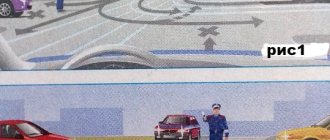Summary Conversation with parents about traffic rules. Questionnaire for parents.
CONVERSATION WITH PARENTS:
“Running across the road is the enemy. Especially in winter"
Children persistently run across the roadway. Why? The most common answer: “It’s faster!” Let's think about it. Still, the baby is afraid of the road, the place where cars pass, and wants to overcome it faster. So to speak, “a mistake with good intentions.” Moreover, we, adults, are often to blame for the appearance of this error, hurrying the child: “Why are you digging? Faster!".
The usual state of children is to move and run. Especially next to adults. The child's stride is shorter - he can barely keep up with mom or dad. This is how a strong habit is developed! How many hundreds of kilometers has your child already run in the house? Near the house? On walks? In principle, although beneficial for a child’s development, this habit is harmful on the road!
Dear parents! When you return home, ask your child the question: “What is the danger of running across the road?” What will they tell you? Often children give the most strange and unexpected, illogical answers like “The driver can run you over.” This is not entirely true. Closer to the truth: “You can trip (in summer), slip (in autumn and winter) and fall.” But this is not the main answer. “You might not notice the car.” This is already the most important thing.
Ask your son or daughter the following question: “How does someone running across the street observe? Can he look around? Can not. That's the whole point!
That is why it is so important for children to develop a stable skill WHEN TRANSITIONING, CONTINUE TO WATCH THE ROAD IN BOTH WAYS, FIRST MORE TO THE LEFT, THEN MORE TO THE RIGHT.
Not “First look to your left. When you reach the middle, look to the right,” namely, “Look in both directions”! After all, the street is constantly changing! A stationary car could move, a slow-moving car could speed up. The one that was going straight, suddenly turned. Hidden behind another parked car or around a corner - emerge. Observation must be DUPLICATED!
How to do this when running? No way!
Here is the main answer: the one who runs, his eyes are directed forward and practically cannot look around. He's almost blind...
But this is not enough, let's get to the bottom.
What exactly is running? How is it different from walking?
When a person walks, with each step there is a moment when both feet are on the ground at the same time. The benefit of crossing by STEP is stability when moving; YOU CAN CALMLY TURN YOUR HEAD both to the left and to the right as many times as necessary according to the situation and the width of the street.
On the street, the most important and most difficult thing is to observe and notice.
There is knowledge. Understanding is the utmost. But the habit “sits”, and firmly. But the man on the street does not think, but acts as usual. And in order to elevate your child’s correct actions when crossing the street to the rank of habit, practice with him - in the yard, in the park, at home - a simple exercise: crossing the road while observing.
Train the movements in stages. First, you show your child how to act: stop at the edge of the sidewalk, look left, then right and left again. Only after this can you begin to move without stopping to observe (with your head turned!). Before the middle of the roadway, we pay more attention to observation to the left, after the middle - to observation to the right. The next step is to practice these actions together with the child: bringing these actions to automatism. The final step is for the child to cross the “road” independently, consolidating the acquired skills.
In winter, running across the road is doubly dangerous!
Snowfall, ice, even just wet asphalt, watered or sprinkled with anti-icing agents, increase the braking distance many times over. Stopping a moving car becomes ten times more difficult! From sudden braking, the car may skid or skid (when the wheels lock and it becomes uncontrollable). And then the trajectory of its movement becomes completely unpredictable.
This means only a calm transition, only at a pace, only the utmost attention to the road and the traffic on it! A habit trained to automaticity will help your child safely cross the road alone, with a friend, with skates or skis in hand. She will simply become his safe conduct on the road.
CONVERSATION WITH PARENTS:
How to use a walk to instill in your child the skills of safe behavior on the street, practicing the “My way to school” route
General recommendations
You should leave the house in advance - so that there is a reserve of time. The child must get used to walking along the road slowly.
When you see a bus at a stop on the opposite side of the street, do not rush, do not run across the street towards it. Explain to your child that this is dangerous. You can get hit by the wheels of a moving car.
Show your child where the transition is. Watch how you cross the roadway: not diagonally, but strictly perpendicular. The child must realize that this is being done to better monitor the road.
When going out onto the roadway, stop extraneous conversations with your child. He must get used to the fact that when crossing the road he must focus on monitoring the traffic situation.
Where there is a traffic light, cross the street strictly when the signal is green.
Cross the street only at pedestrian crossings, and at an intersection - along the sidewalk line.
Exit from the entrance
Houses
If there is possible traffic at the entrance of the house, immediately draw the child’s attention and look together to see if there are any cars.
If there is a car parked at the entrance or a tree growing that blocks your view, stop and “look” to see if there is a hidden danger behind the obstacle.
Driving on the sidewalk
Periodically draw your child's attention to cars appearing in the distance and passing by, especially those that are traveling at high speed. Teach your child to notice vehicles from afar, follow them with their eyes and judge their speed.
Stop at a stationary vehicle and draw your child's attention to how it blocks the view of the street. You might think that there is no danger and go out onto the roadway, and at that time another car will pull out from behind a standing car.
It is useful to do such observation while walking with various objects that block the view of the street - bushes, trees, fences, etc.
As a result of such observation, children develop the reflex of anticipating hidden danger, which is most important for safety on the street.
Crossing the road
Part,
where there is no traffic light
While walking and on the way to kindergarten, school and back, teach your child to stop when approaching the roadway. Stopping will allow him to switch gears and assess the situation. This is the main rule of a pedestrian.
At an intersection, teach children to notice vehicles preparing to turn right (primarily) and left. As a rule, vehicles turning right are in the extreme right position and turn on the right turn signal, while vehicles turning left are in the extreme left position and turn on the left turn signal.
When watching large vehicles passing through the crossing, draw the child’s attention to the fact that while this car has not moved far, it may be hiding another that is following it. Therefore, it is better to wait until the large vehicle moves further away.
Boarding the bus
travel and exit
Approach
the door only when the bus has come to a complete stop.
Teach your child to hold on to the handrails on the bus and give up his seat to older people.
You need to prepare for the exit in advance. Explain to your child how the driver uses a mirror to see passengers at the bus stop and inside the bus. Teach that sometimes, if there are a lot of people, the driver may not notice the passenger and pedestrian.
Get off the bus with your child in your arms or in front of him. If the child gets out first, he may run out onto the roadway. Or he might fall because the steps on the bus are quite high.
It is especially useful to show your child from the sidewalk the moments of passing or oncoming traffic. At the same time, the child develops a conditioned reflex of anticipating hidden danger.
When you get off the bus, cross to the other side of the street only at the pedestrian crossing.
Memorizing the route to school and home.
While driving down the street, show your child road signs and explain their name and purpose. Show all types of pedestrian crossings. Pay attention to the traffic lights, explain the meaning of each of them. Show the presence of shops, pharmacies, public transport stops, and street names.
Together with your child, draw a route to kindergarten or school. Show us the most dangerous sections of this route. Draw the safest path along this route. Then walk along the drawn route several times, both on the diagram and on the street.
QUESTIONNAIRE FOR PARENTS.
(Underline the answer.)
1. Does the family have their own personal transport? (Not really.)
- Are there any professional drivers in your family? (Not really.)
- What age are the children in the family?
- Where can you find out about traffic accidents involving children:
- at meetings in kindergarten, school;
- from conversations;
- on television, radio, in print?
5. How does your child know the traffic rules?
- I think that he knows at “5”, “4”, “3”, “2”.
6. Who taught the child to follow the rules:
- kindergarten; -school;
- the parents themselves;
- grandmother grandfather.
7. How often do you tell your child about the need to follow the Rules: daily;
Sometimes;
very rarely;
We don’t talk about this topic;
other answers.
8. Your child has become a first grader. What did you do to ensure that your first grader crosses the road correctly:
showed the shortest and safest route from home to school; walked along this path several times with the child, showing how to cross the road correctly; other measures (specify).
9. Do you yourself follow the traffic rules: I always do;
not always; I don't comply.
10. Do you break the Rules when you go with your child: no;
sometimes it happens when we are in a hurry;
We don’t pay attention to the traffic lights or the cars.
11. How does the child react to your violation: does not react at all;
says we are going wrong; requires that they walk correctly.
Conversation with parents “Road rules for children”
The problem of road safety is currently one of the most important problems. The population is growing, and the number of cars owned by private individuals is also increasing. All this would be good if it were not associated with an increase in the number of road accidents. Unfortunately, they also happen with the participation of school-age children. Often a child underestimates the real danger that threatens him on the road.
Parents should instill in their children respect for traffic rules and the habit of strictly observing them. Some mothers and fathers hope that this behavior will be instilled in them at school. It often happens that it is parents who set a bad example for their children: they cross the road in places where this is prohibited, and put children under 12 years of age in the front seats of their cars. All this leads to an increase in child road traffic injuries. It is enough to have a conversation-game with your child on the rules of the road at least once a week for 10-15 minutes so that he looks at the situation with different eyes. Such a child will later be able to navigate independently in difficult situations on city highways. And if the child is well versed in the rules of the road, parents can be calm about him. A common mistake made in such cases is the wrong approach to starting a conversation. Talking to children about the dangers of the road in an overly stern tone is ineffective. In this case, the child will not be interested in the conversation and, as a result, will learn only a small part of the information. It is much more effective to talk to your child calmly, choosing a moment when he is not busy with anything and his attention is at your disposal. Before explaining, indicate the importance and seriousness of the conversation, let the baby feel his importance. His attention near the road should be a request, not a demand. He must understand that they are worried about him and that he is in danger. This motivation is much stronger than fears of punishment or reproaches. Another common mistake parents make is acting on the principle “you can do it with me.” If you show your child by your own example how to run to red, be sure that when left alone, he will try to repeat this trick.
Remember!
The child learns the laws of the roads, following the example of family members and other adults. Especially the example of dad and mom teaches disciplined behavior on the road not only to your child, but to other parents
Take care of the child!
Protect him from accidents.
TO NEVER FIND INTO DIFFICULT POSITIONS, YOU MUST KNOW AND FOLLOW THE TRAFFIC RULES! YOU SHOULD ONLY CROSS THE STREET WHEN THE TRAFFIC LIGHT IS GREEN! PLAYING NEAR A DRIVEWAY IS DANGEROUS! BE CAREFUL WHEN CROSSING THE STREET! WALK AWAY WITH THE TRAM IN THE FRONT, BUS AND TROLLEYBUS IN THE BACK. CROSS THE STREET ONLY IN PLACES MARKED FOR CROSSING




